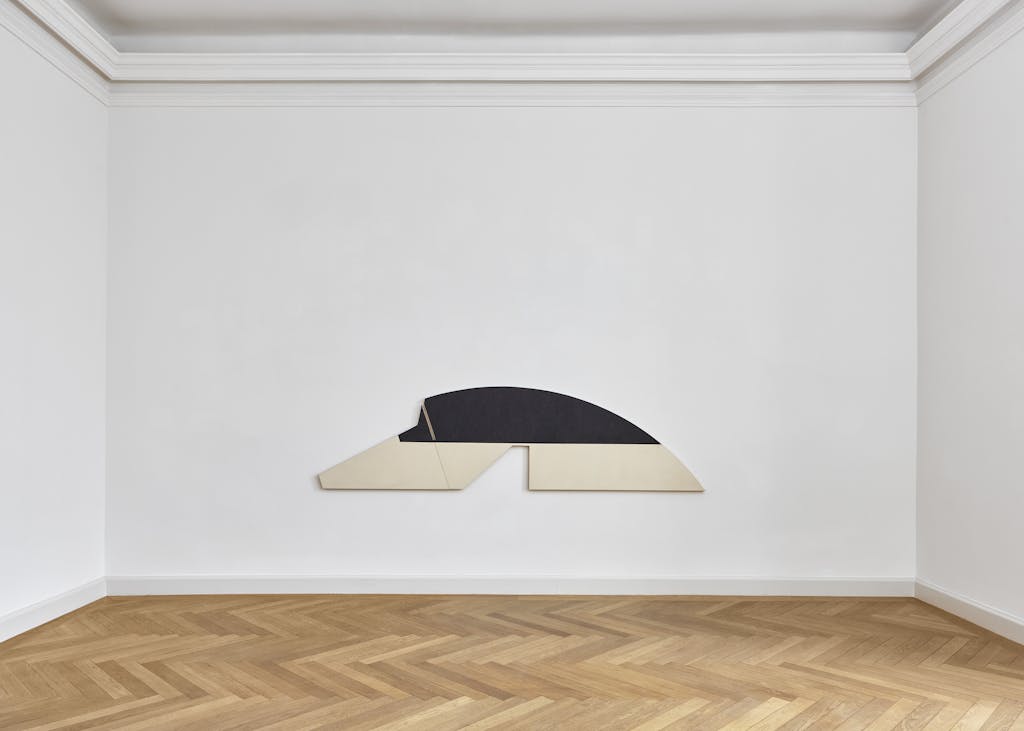TED STAMM
SERIES
28 Apr 2023 - 7 Jul 2023
Berlin

In 1975, the Düsseldorf avant-garde gallery December gave the then thirty-year-old American Ted Stamm his first solo exhibition in Germany. Even today, the artist is still a new discovery to many; almost five decades after this premiere, his work, which combines early approaches of Minimal Art and Conceptual Art, seems surprisingly fresh and contemporary.
Ted Stamm (1944–1984) represents a remarkable position within the New York art scene of the 1970s and early 1980s. At that time, Stamm and other artists such as Peter Halley, Mary Heilmann, Kenneth Noland and Sean Scully were looking for ways to expand the content and form of abstraction that modernist painting had to offer. While often only object art, performative or text-based art forms were considered contemporary, for these artists painting remained the focus of their work.
This was also true for Ted Stamm. However, his examinations went far beyond this and resulted in an extraordinarily multilayered body of work. The different series of works in his painting, his drawings and the photographically documented street art projects are, as is shown in this exhibition and as is also illustrated by means of archival material, related in complex ways.
One of the first phases of his search is marked by his 'Cancel' series, in which in the early 1970s, encouraged by his teacher Perle Fine and influenced by Ad Reinhardt, he almost completely painted over his early, lyrical abstract paintings with black paint. This was followed by experiments in the 'Chance' series, in which, involving randomness, he made the number of layers of colour and the tonal values of the black paint dependent on the results of dice and the spinning of a roulette wheel.
Of outstanding importance in Stamm’s work is the 'Wooster' series; it was the continuation of earlier experiments with lines and shapes that led to the creation of the 'Wooster' form. Inspired by the ground plan of a piece of land near his studio in SoHo, he developed a simple yet complex form in 1974: a square in combination with a triangle. Both basic forms merge to form a single shape, which in stretched distortion is given a variation, 'Lo Wooster'.
The 'Dodger' shape, inspired by the shape of a baseball field, is comparatively complex and allows a multitude of variations: It describes a flat arc on the upper right side, which usually tapers to a point on the right. On the left, irregular, polygonal shapes are added in each case, with unexpected breaks and empty spaces.
Both series of works, as well as the somewhat later 'Zephyr' series, share the creative concept of the individually shaped canvas, which artists such as Frank Stella had introduced into painting at that time, and which Stamm preferred using. By rejecting the classical rectangle, the depicted form could now be placed in a new context that, in perception, linked the composition with the image in space.
His iconic 'Wooster' and 'Dodger' works are initially defined by the beauty of the simple form. Executed in his paintings and drawings, as well as projected as sculptural installations, he finally integrated these works into his 'Designator' series, which carried his ideas into public space in a well-thought-out guerrilla manner, as interventions that he systematically documented and archived with a camera.
Stamm’s series of works entitled 'Tag' from the late 1970s onwards also has a documentary character. Found clothing labels (tags) were processed both by studio visitors and by Stamm himself in drawings or paintings. Both sketchbooks were dated and thus document the exchange between the two counterparts. In addition to these collaborative works, Stamm also created independent 'Tag' works, which can also be seen here.
Ted Stamm left behind a considerable body of work after his early passing. And from his oeuvre, we can see that we are dealing with an artist who developed and constantly advanced work ideas across all media. He explored visual problems of representation and perception and approached them conceptually. This has resulted in a minimalist visual language that often appears strictly geometric and modest, but at the same time occupies large spaces of freedom. Stamm’s constant engagement with his environment and his tireless experimental way of working can be seen in this exhibition.
KEWENIG takes this exhibition as an opportunity to publish the most comprehensive, richly illustrated monograph on Ted Stamm to date, which is published by Hatje Cantz and includes contributions by Tiffany Bell, Christine Mehring, Jeffrey Saletnik and Andrew Wasserman, among others. The catalogue provides deep insight into the life and work of the artist, who exerted a lasting influence on a large number of artists of his time and subsequent generations.
Stamm's works were shown in the following solo exhibitions, among others: the Clocktower P.S.1, New York, (1981); P.S.1, Long Island, New York (1978); Artists Space, New York, and Galerie December, Düsseldorf (1975). He participated in Documenta 6 in Kassel (1977), curated by Manfred Schneckenburger.
Works by Ted Stamm are represented in the following collections, among others: Brooklyn Museum, New York; Carnegie Museum of Art, Pittsburgh; Fondation Louis Vuitton, Paris; Hall Art Foundation, Derneburg, Germany, and Reading, Vermont; Los Angeles Museum of Contemporary Art; San José Museum of Art; Phoenix Art Museum; Museum of Modern Art, New York; Solomon R. Guggenheim Museum, New York; and Western Australia Art Gallery, Perth, Australia.
Installation views
Video
Works
Ted Stamm
DSG-103A (Dodger Designator), 1977/2023